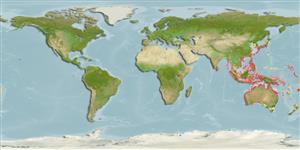Common names from other countries
Environment: milieu / climate zone / depth range / distribution range
Ecologie
marien rifbewoner; diepte 0 - 10 m (Ref. 93839). Subtropical
Western Pacific: subtropical, from southern Japan to Taiwan, then from subtropical Australia to New Caledonia and the Kermadec Islands.
Grootte / Gewicht / Leeftijd
Maturity: Lm ? range ? - ? cm
Max length : 14.0 cm TL mannelijk / geslacht onbekend; (Ref. 559)
Dorsale stekels (totaal): 8; Dorsale zachte stralen (totaal): 9; Anale stekels 2; Anale zachte stralen: 8. Distinguished by having the following characteristics: dorsal fin rays VII-I, 9; anal fin rays II, 8; pectoral fin rays 15; pelvic fin rays I, 5; pored lateral line scales 24; predorsal scales 3; circumpeduncular scales 12; body pinkish brown, with four dark brown stripes on lateral surface of body; third stripe posteriorly not reaching to a black spot on caudal fin base; caudal fin base spot subequal in size to pupil diameter (Ref. 93839).
Commonly occurs in rocky areas near shore and abundant on ledges. Solitary but pair off during breeding. Mouth brooding is done by the male. Nocturnal species (Ref. 7300).
Mouthbrooders (Ref. 240). Distinct pairing during courtship and spawning (Ref. 205).
Randall, J.E., G.R. Allen and R.C. Steene, 1990. Fishes of the Great Barrier Reef and Coral Sea. University of Hawaii Press, Honolulu, Hawaii. 506 p. (Ref. 2334)
Status op de Rode Lijst van het IUCN (Ref. 130435)
CITES (Ref. 128078)
Not Evaluated
Gevaar voor de mens
Harmless
Gebruik door de mens
Meer informatie
ReferentiesAquacultuurAquacultuurprofielKweeklijnenGeneticaElectrophoresesErfelijkheidZiektesVerwerkingMassaconversie
Tools
Speciale rapporten
Download XML
Internetbronnen
Estimates based on models
Preferred temperature (Ref.
115969): 20 - 28.9, mean 27.6 (based on 1621 cells).
Fylogenetische diversiteitsindex (Ref.
82804): PD
50 = 0.5000 [Uniqueness, from 0.5 = low to 2.0 = high].
Bayesian length-weight: a=0.01413 (0.00807 - 0.02472), b=3.17 (3.02 - 3.32), in cm Total Length, based on LWR estimates for this species & Genus-body shape (Ref.
93245).
Trofisch niveau (Ref.
69278): 3.6 ±0.56 se; based on food items.
Weerstandsvermogen (Ref.
120179): Hoog, minimale populatieverdubbelingstijd minder dan 15 maanden (Preliminary K or Fecundity.).
Fishing Vulnerability (Ref.
59153): Low vulnerability (10 of 100).
